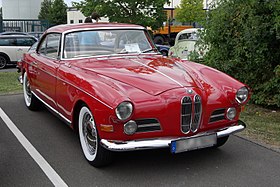BMW 503
| BMW 503 | |
|---|---|
 |
|
| Overview | |
| Manufacturer | Bayerische Motoren Werke AG (BMW) |
| Production | May 1956 – March 1959 413 built |
| Designer | Albrecht von Goertz |
| Body and chassis | |
| Class | Grand tourer (S) |
| Body style |
2-door 2+2 seater coupe 2-door 2+2 seater cabriolet |
| Layout | FR layout |
| Related |
BMW 507 BMW 502 |
| Powertrain | |
| Engine | 3,168 cc (193 cu in) BMW OHV V8 |
| Transmission | 4-speed manual |
| Dimensions | |
| Wheelbase | 2,835 mm (111.6 in) |
| Length | 4,750 mm (187 in) |
| Width | 1,710 mm (67 in) |
| Height | 1,440 mm (57 in) |
| Curb weight | 1,500 kg (3,300 lb) approximately |
| Chronology | |
| Predecessor | BMW 327 |
| Successor | BMW 3200 CS |
The BMW 503 is a two-door 2+2 grand touring automobile from the 1950s. BMW developed the 503 alongside their 507 roadster in an attempt to sell a significant number of luxury cars in the United States. The 503 and 507 cost about twice their projected price and did not recover their costs. During production from May 1956 to March 1959, 413 units of the 503 were built. Even though it was a top and prestige model it resulted in heavy losses for BMW.
Hanns Grewenig, sales manager of BMW, repeatedly requested the development of a sports car based on their 501 and 502 luxury sedans. In early 1954, influenced by the public reaction to Mercedes-Benz 300SL and 190SL show cars in New York in February 1954, the management of BMW approved the project.
Max Hoffman, an influential automobile importer in the United States, saw early design sketches by BMW's Ernst Loof, and suggested to industrial designer Albrecht von Goertz that he should submit design proposals to BMW. Based on these proposals, BMW contracted Goertz to design the 503 and 507 in November 1954.
The 503 was a 2+2 grand tourer that was available as either a coupe or a convertible. It was noted for having a cleaner and more modern design than the "Baroque Angel" 501-based sedans. The convertible version of the 503 was the first European convertible with an electrically operated top.
BMW 503 coupe
BMW 503 convertible
Interior
Tasked with designing rolling chassis for two cars while using as much as possible from the existing 502 sedan, engineer Fritz Fiedler designed two versions of a new ladder frame, one with the same wheelbase as the 502, and one with a shortened wheelbase. The long-wheelbase version was used in the 503. Both cars used the steering system and a variant of the front suspension system from the 502; the 503 also used the 502's rear suspension. As originally designed, the 503 used the 502's remote gearbox placement and shift linkage. Both cars used the braking system developed for the 3.2 sedan, using drum brakes with vacuum assist. All 503s were configured for left hand drive.
...
Wikipedia
